Tezuka Osamu
Tezuka Osamu, often called "the god of manga," was responsible for many of the twentieth century's biggest hits. His accomplishments include titles such as Black Jack, Astro Boy, and the work that many people consider to be his masterpiece, Phoenix. Rare documents and interviews with assistants reveal some of the secrets to his success. Tezuka stayed at his drawing board until his death in 1989. Join a star of the contemporary manga scene, Urasawa Naoki, as he explores the artistry of one of the medium's major figures.
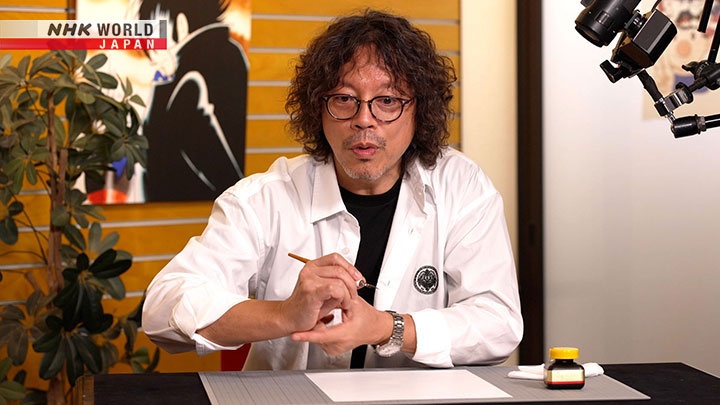
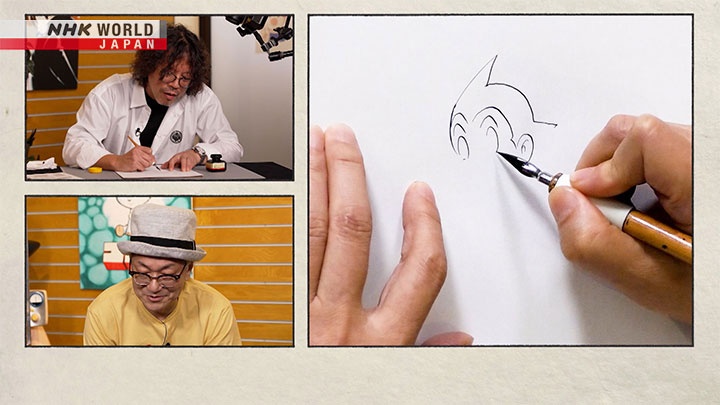
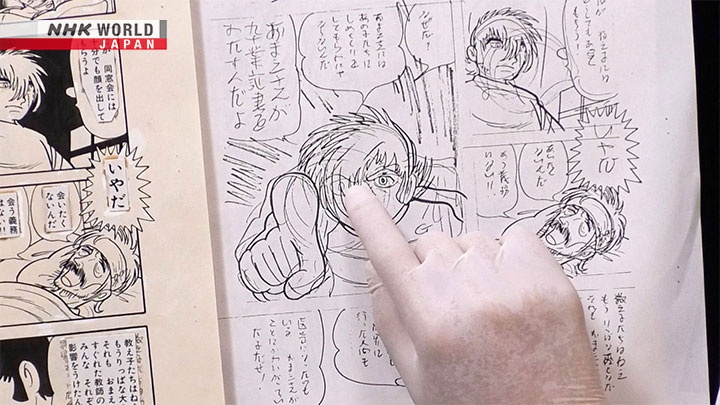
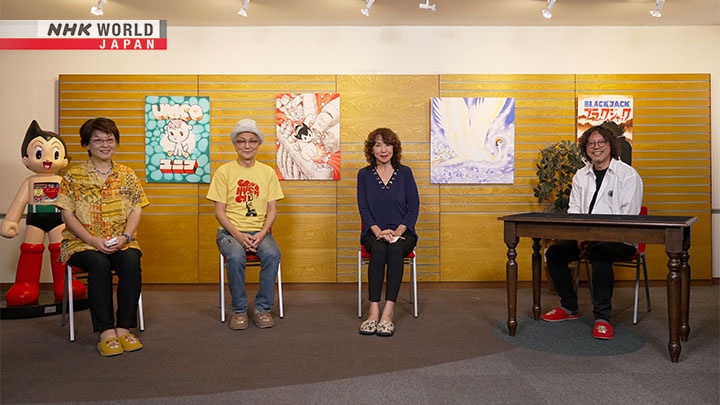
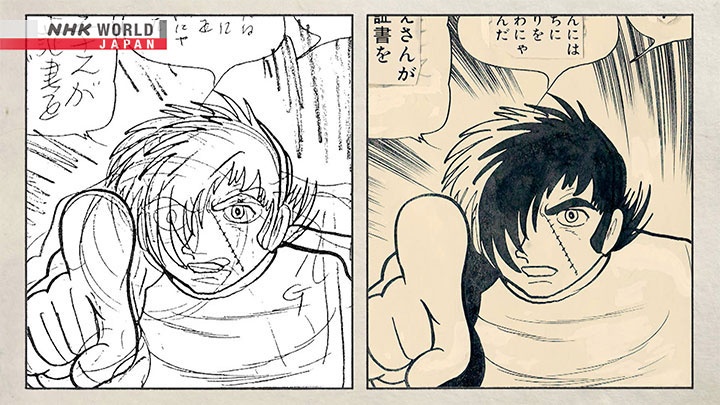
Transcript
The rough draft is just a draft.
When inking the final draft, you must
put your heart and soul into the pen.
That's how you create imagery
that attracts the reader's attention.
It's fascinating how simple lines
can bring a manga to life.
In this episode, we'll be discussing the amazing linework of Tezuka Osamu.
This is the first time we're featuring an artist no longer with us.
His works include "Astro Boy," a sci-fi manga about a robot with emotions,
"Princess Knight," pioneer of the shojo manga genre,
The famous manga about medicinal work, "Black Jack,"
And "Pheonix," an epic tale of people seeking eternal life as they wrestle with fate.
Over his career, Tezuka released nearly 700 manga across a wide variety of genres.
His undeniable influence has led to his nickname, "The God of Manga."
Urasawa Naoki, one of Tezuka's many fans, is remaking "Astro Boy."
I have always wanted to create
a manga like Tezuka Osamu.
Somehow, simple lines on a page
fill us with excitement.
Quick lines. Soft lines. Shakey lines.
Seeing such impressive linework
shook me to the core.
As a kid, I always wondered
how these lines were made.
Maybe now I can find out.
Niiza City, Saitama Prefecture.
We have some formidable guests today.
We'll look at rare, original manuscripts
and disucss the genius of Tezuka Osamu.
This is where Tezuka worked in his later years.
Here, three of his assistants join Urasawa Naoki for a special conversation.
Ishizaka Kei is known for creating "It's Easier than Kissing" and "I'm Home."
Takami Mako created "My dear Ellie," a manga about a teacher and student who fall in love.
And Hotta Akio, who recently released a manga about being Tezuka Osamu's assistant.
What year did you start as assistants?
1978.
All three of us.
That must have been fun!
We were all big fans of Tezuka-sensei.
I could have been in this picture, too.
Let's explore the secrets behind Tezuka Osamu's creativity through his original art,
a variety of resources, and first-hand testimonies.
First, here's Tezuka's schedule notebook.
It's from the period when our guests worked as his assistants.
Deadlines pack the page.
This was one of the busiest times of Tezuka's career.
I see lots of "Weekly Shonen Champion."
This is "Black Jack."
- Magazine, with...? - "The Three-eyed One?"
"Big Comic." "MW."
- And "Kibo no Tomo." - With "Buddha."
- And "Lyrica?" - "Unico."
And "Manga Shonen," with "Pheonix."
I can't believe this!
How many in total?
Tezuka worked on multiple series at the same time.
This month, he had 18 deadlines.
How many pages did he finish?
A total of 266!
As any fan of a Tezuka manga knows,
the themes are diverse,
and the readership is vast.
Thinking about it now,
I don't know how he did it.
A team of ten wouldn't be able
to get this done today.
When our guests started as assistants, "Black Jack" was a huge hit.
They all helped put together the popular series.
The main character is a surgical genius with no medical license.
The story often pushed readers to ponder the meaning of medical care.
The classic series has influenced many to pursue a path in medicine.
Hotta brought some rare materials to give us a glimpse into the production process.
These are copies of 23 unfinished pages from "False Image," episode 232 of Black Jack's serialization.
The copies feature lines not found on the finished pages.
These valuable documents give us a rare look into Tezuka's process.
You held on to these?
Yes, with most of the main lines.
He starts with the main characters.
This is what he would give us first.
Tezuka-sensei split up the panels
and inked the characters.
We would first ink panel lines.
We adjust pressure for different lines.
He mostly used a spoon pen, right?
Yes.
I think it's the only one he used.
What did you all use?
A spoon pen.
Even for narrow and detailed lines?
Even panel frames.
Adding pressure would make thick lines.
This image is full of real emotion.
Tezuka-sensei's lines have so much life.
You could see how much pressure he used
to draw different images.
He put so much pressure in some panels
it looked like the paper might rip apart.
I see the pressure used for the shoulder.
I love this part! Black Jack's profile.
Look at how simple the rough draft is!
That's right.
Although he sometimes used pencil
for important scenes or close-ups,
Tezuka-sensei rarely ever sketched.
He went straight to inking. Even faces.
He had no time to storyboard.
He worked directly on the manuscript paper.
Always pressed for time, Tezuka would ink manuscripts with minimal sketching.
After dividing frames and deciding composition, he moves directly to main character lines.
Momentary expressions that exist in Tezuka's imagination are instantly engraved onto the paper.
I noticed he always draws the border
of Black Jack's black and white hair.
Of course.
His outfits also use lots of blacks.
Some of Tezuka-sensei's lines get covered.
Even though Black Jack's arm is drawn,
the black cape covers it up.
I always thought that was such a waste.
I would color over the lines thinking,
"Nobody will see these but me!"
This would all be black.
Exactly. You understand!
You have no choice but to cover it up!
Why draw it if it's going to be erased?
Let's compare the panel with the final manuscript.
Look at that!
The main line for Black Jack's arm is gone.
And in the panel of Black Jack's profile that Urasawa mentioned earlier...
It's all black.
That means those lines I liked are gone.
It's true. They're coved up.
Tezuka-sensei spared no effort.
The finished page is perfect as it is.
But it's still so exhilarating
to see the lines lost in the process!
And here! He drew both eyes.
Nice find!
He drew both of Black Jack's eyes.
The full face.
It's an important moment.
Black Jack presses his ailing mentor to meet his former students.
To get the look perfect -
- Tezuka sketched out the right eye, even though he knew it would be covered up.
You get a sense of his rhythm.
You could feel his creative force
as he worked on decisive scenes.
What's "G"?
- White. - I see.
Tezuka-sensei wasn't interested in white.
Being in a magazine was all that mattered.
He considered the finished product to be
what was printed and delivered to readers.
He didn't care how it looked before that.
Like a plate used for printing.
The G section starts here.
The line didn't push him forward enough.
So, he made another above.
There's another line on top of that.
He was experimenting.
I see! The position of the line
can really change the character's posture.
In this panel, Tezuka drew different lines for Black Jack's shoulder.
He was searching for the line that perfectly expressed the emotion of the moment.
This is the final, assertive panel created by the God of Manga.
There's something else about Black Jack that piqued Urasawa's curiosity.
Episode one of the serialization - the first panel to feature a close-up of Black Jack's face.
This is the page where Black Jack
makes his first appearance.
- If you look at the eyes...
- It looks like pasted paper.
As you can see, Black Jack's eyes have been redrawn.
Did the character have a different face?
What did it look like?
Our program was granted permission to photograph the manuscript with an infrared camera.
The result?
We found two lines that didn't make it to the final manuscript.
What was Tezuka-sensei trying to do here?
It looks like two different eye sizes.
But it is evident that he created the character on the page.
He was too busy to use a separate sheet.
He was still unsure.
Around this time,
"gekiga" had become the popular manga style.
The trend ended many series,
putting Tezuka-sensei in a tight spot.
From the end of the 1960s and into the 70s,
Tezuka entered a difficult period he later called his "winter era."
All the attention was on "gekiga" manga,
a dramatic genre that depicts the darker side of society with realistic art.
On the other hand, Tezuka's manga featured round, cute characters with large faces and eyes.
Some people even began to call Tezuka Osamu's works "too childish" and "outdated."
Tezuka studied the "gekiga" genre, searching for something brand-new to create.
He ended up releasing "Alabaster."
After being betrayed, the main character gets involved in the world of crime.
Unfortunately, it wasn't the hit Tezuka hoped for.
Here's footage of him looking back on the series.
I drew this at my lowest point.
It was never going to
resonate with readers.
People told me it was gloomy.
They used words like
"gruesome" and "dark."
I agree. My art was coming
from the bottom of a dark pit.
Tezuka used to work on ten series at once, but that number quickly dwindled.
As the creator tried to adjust to a new era of manga,
he eventually came up with the famous character Black Jack.
Tezuka-sensei must have been feeling down.
This story was like his big comeback.
He wanted to create something new.
There was a certain darkness about him.
But showing that in "Alabaster" is something
Tezuka-sensei probably didn't enjoy.
Same for readers.
Eventually, he found a way
to express darkness inside a manga.
The best example of that is Black Jack.
It's dark entertainment.
Considering all that,
the hesitation on the page shows
that Tezuka-sensei was still figuring out
how to play his cards.
It would feel completely different
if he used the first lines he drafted.
The lines on top add a sense of maturity.
He's more than just a cute face.
This is just my personal analysis,
but for his more mature manga,
I think he aimed for a look
similar to the "Golgo" series.
Look at the thick eyebrows,
and how the eyes get thinner.
He must have been trying to make something
opposite from his large-eyed characters.
With this series of panels,
I can see he was aiming for something new.
The "gekiga" manga boom led to the birth of Black Jack.
Notice how the character's eyes get narrower in the back half of its serialized run.
Tezuka Osamu was born in 1928 in Osaka.
His love for manga began at a young age,
and at 9, he became the popular kid at school with his manga "Pinpin Sei-chan."
In 1946, Tezuka debuted at 17 with the four-panel newspaper manga, "Ma-chan's Diary."
A year later, he released "New Treasure Island," a hit that has sold more than 400,000 copies.
Release after release, Tezuka continued to expand the potential of the medium.
Expressing emotion in a single manga image was considered difficult.
Tezuka tested out different eyebrows, eyes, and mouths.
And other things like sweat flying off characters.
Tezuka was able to convey a variety of emotions in static images.
He is also credited with establishing the current way of reading Japanese manga: from top right to bottom left.
The manga legend is responsible for discovering numerous techniques considered standard practice today.
One of those discoveries was to have assistants work on backgrounds.
Manga artists could focus on characters and inking
while letting assistants work with rough background sketches and simple orders.
This one.
Tezuka created a manual to guide his assistants with background work.
Here's what it looks like.
A quick glance helped assistants grasp the background Tezuka wanted.
For example, "infinite 1" refers to this detailed pattern.
"Barbora grass" is for grass like this.
For this panel in Black Jack, Tezuka has written "Z."
This refers to thin horizontal lines, which look like this on the finished page.
First-years spent a lot of time inking.
But before that,
we needed to master all of these lines.
Assistants must be able to draw lines
that look identical to each other.
Even now, I can tell which pages
were drawn by which assistant.
The lines have their own unique flavor,
which is another way to enjoy the work.
Looking at this reminds me
of the stuff I made in high school.
When we didn't have screentones,
we had to create the effects by hand.
Tezuka stayed on top of all the latest trends.
He updated his art depending on the popular manga and artists of the time.
This is a Moebius cloud.
Very difficult.
It's a detailed line
French artist Jean Giraud was skilled at.
Tezuka-sensei seemed to be
quite conscious of his work later in life.
A lot of his later manga used these lines.
When our three guests were Tezuka's assistants, the manga author decided to take on a new magazine.
"Lyrica" was first published in 1976.
Every page was full color and read horizontally from left to right.
The goal was to appeal to international audiences.
Tezuka created "Unico" for the magazine.
Full-color manuscripts were a lot for the assistants to take on.
Before coloring the final image, they would practice recreating the colors in Tezuka's guide.
I compared your test pages.
The goal was to get close to the colors
in Tezuka-sensei's guide.
I was a first-year assistant!
Tezuka-sensei judged these, right?
Takami's is on the left, and Ishizaka's is on the right.
We found these while preparing for today's discussion.
Take a look!
Wow. This is horrible.
The blur is so bad.
- No blur at all.
- None.
The goal was to recreate both Tezuka's original colors and the gradation.
Tezuka created a color spec chart so that anyone would be able to color his manuscripts.
Each color has three different shades.
Tezuka-sensei only used the eleven colors
found at elementary schools.
Especially with "Unico,"
evenly recreating the blues was difficult.
And then blurring the colors
was even more challenging.
Coloring on your own isn't a problem.
But copying Tezuka-sensei's colors evenly
can't be done in a day or two.
You can tell if you look closely.
The shadows on both of your pages are muffled.
Tezuka-sensei's shadow is clear.
In Tezuka's example, the shadows are clearly drawn from the ear down the neck.
In comparison, you can feel a bit of hesitancy in his assistants' shadows.
It's like the light is shining from below.
The aggressive shadowing
gives the image a three-dimensional feel.
It has so much life.
Proper shadowing can give an image three-dimensionality, which helps bring Unico's face to life.
You can really see the skill gap
between Tezuka-sensei and his assistants.
Don't forget that comment, Mr. Urasawa!
NHK has rare footage of cameras documenting Tezuka Osamu as he worked.
An unmanned camera was used to not disturb the artist.
Are you filming?
This is strange.
Like the camera is staring at me.
This program is actually what inspired Urasawa Naoki to create Manben.
Although in a different era, this show was filmed in the same place the assistants worked.
It was the dream to come
to Tokyo's Takadanobaba area.
Everything was so shiny.
- Brings me back.
- Me too!
- Is that building still around?
- Yup.
The assistants worked in a large room on the second floor.
Tezuka's workspace was on the fourth floor.
The team worked separately.
Tezuka-sensei would give us
our assignments at the entrance.
We had no idea about the other rooms.
He starts by playing a record.
So fast.
Tezuka-sensei had a unique way of drawing.
He would get calluses here.
His pinky finger is raised up.
The bottom of his hand was the pivot.
Like this.
If you look closely, you can see Tezuka slightly lifting his pinky.
I rest my hand like this.
- That's usually the case.
- My pinky hits the page.
Many people place their pinky finger on the table like this when writing or drawing.
However, Tezuka slightly raised his pinky, using the palm of his hand as the pivot point.
How do they differ?
Sometimes Tezuka-sensei would get in a car
and start drawing with a board on his lap.
He also drew while lying on his stomach.
You can't use your pinky like this.
- You need to use your palm. - That's true!
None of us can do it, but someone
of your caliber might be capable.
Tezuka used thin white sheets of foreign paper.
Urasawa attempts to draw using Tezuka's technique.
Is that Black Jack? Wow.
The small details are hard to do
without anchoring my pinky.
I can't do it this way.
This is hard.
How about this?
So difficult!
But this is great
for drawing lines like this.
Using your palm as a base
helps to make smooth, soft lines.
More can be learned from NHK's rare footage.
Tezuka places something underneath the manuscript.
He gets soft lines by drawing over a copy of "Asahi Graph."
Tezuka drew on top of large, thin magazines.
It's so puffy!
This really changes things.
How does the soft surface feel?
It definitely leads to softer lines.
You don't seem comfortable.
Not at all. Too soft.
You get used to it.
Why such thin paper?
I think he liked how the pen digs in.
- "Asahi Graph" is key.
- Exactly.
Thin paper pairs great with the magazine.
- So cute!
- With no rough draft!
I get it now!
The soft feel of the magazine
made me want to draw Astro Boy.
Really!?
It's like the soft surface
is telling me to make lines like this.
- It demands it.
- Aggressive lines are impossible.
- I want to draw stuff like this.
- Round imagery.
Tezuka came up with adorable characters one after another.
His unique way of drawing probably played a big part in his character designs.
Our three guests also share a special connection with "Phoenix."
Humans fight over the blood of a phoenix, which is said to give eternal life.
What is life? Death?
And what does it mean to be human?
The stories in "Phoenix" cross multiple eras, from the distant past to far in the future.
There's a special reason Tezuka made working on "Phoenix" his lifework.
Tezuka was in middle school when Japan and America went to war in 1941.
At 16, he had a near-death experience during the Osaka Air Raid.
When the war ended and the lights came back on,
no words can express the feeling
of having survived the war.
I still remember how lucky I felt to be alive.
That's one reason why many of my stories
are fixated on survival.
Phoenix beautifully weaves together stories of people determined to "live" and has influenced many.
I read the entire "Phoenix" series
when I was 13.
I couldn't get enough.
Then "COM" came out,
and I got so excited.
I could finally enjoy its serialization!
"Civil War" became the foundation
for my own manga style.
From middle to high school,
all my art looked like this.
I admired it so much.
I couldn't wait for the September issue.
I stopped by the bookstore every day,
but it never came.
I was also in middle school and excited
to read the next episode of "Phoenix."
But it got canceled.
Due to financial troubles at the publisher, the August issue of COM was its last.
The "Civil War" arc ended with just a single episode.
I wanted to read the next part so much
I would dream about it!
I flipped through the pages saying,
"Wow! This is so cool! No way!"
Then I would wake up.
I wanted to know what came next.
Then I heard there was a mysterious copy
of Tezuka-sensei's manuscript!
- Wow!
- It's the continuation.
Tezuka was working on episode two of "Civil War."
We were able to get a look at the unreleased manuscript.
I can't believe I'm holding this!
It starts like this -
- and gets more unfinished as it goes.
Tezuka-sensei was ready to draw it all.
He was! Look at all this.
And then we get here.
This must be early on in his process.
Splitting up panels and adding text.
Which means he already knew
how he wanted to lay out the page.
He already saw everything.
A manuscript with only blank panels and words.
What kind of imagery was going to fill the white space?
All we can do now is imagine.
So he would give this to his assistants,
and direct them on how to fill it in.
Is this historical figure Kiyomori?
Tezuka-sensei already drew him in.
There are even screentones.
Usually, screentones are added
after backgrounds and other imagery.
For nearly finished parts, we just kept our pens moving.
Tezuka's process was all over the place.
He seemingly worked in random order.
Some pages may just be pencil sketches, while others are nearly complete.
This is why this is so valuable.
Tezuka-sensei's rejected manuscripts
give us great insight into his process.
Phoenix "Civil War" began serialization again for another magazine in April 1978.
This was when our guests started working on the series.
How did Tezuka create "Phoenix?"
We asked our guests to select some of their favorite manuscripts.
First up, Ishizaka.
- I remember this!
- I bet!
This is from the middle of "Civil War."
In the mob scene, villagers dance and pray for a bountiful harvest.
When Tezuka-sensei shared the first page,
his editor was already in a bind.
He knew it would take too long
to finish such detailed work.
The chief assistant reassured the editor,
"Since the image features so many people,
assistants will help finish it."
But Tezuka-sensei drew everything,
inked it all, and handed the page in.
A double-page spread filled with 85 dancing villagers.
As the deadline quickly approached, Tezuka inked all the characters on his own.
Tezuka-sensei drew the shadows, too.
They're dancing with hats in their hands,
so shadows change depending on the angle.
I was blown away when I saw this page.
- The movement is so dynamic!
- It's amazing.
We couldn't imagine Tezuka-sensei
working on such minute details.
But maybe he overheard us.
Sometimes it seemed his stubborn demeanor
kept him drawing.
At the same time, this is a page
that makes the readers go, "Wow!"
I get why he would draw it on his own.
It's important imagery.
People dancing around a bonfire during a festival.
The villagers' desire for a bountiful harvest jumps through the page.
Next up is Hotta.
This is the opening color page for Phoenix: "Strange Beings."
Tezuka-sensei drew the main lines
for the swirling lightning
and the two characters at the bottom.
Just the lightning and two characters.
Lightning strikes a mountain path as two travelers pass by.
I was so surprised he drew lightning
from a bird's eye view.
It felt like something brand new.
I don't know if it's correctly portrayed,
but it feels right.
I feel this could be displayed next to
Hokusai's "Thirty-six Views of Mount Fuji."
Especially with how the characters look.
Such fascinating imagery.
Humans stand small in front of nature's majesty.
Their size, paired with a unique layout, creates a compelling frame.
Takami chose one of Civil War's final pages.
The main character is Benta, a farmer with a large build, forced to wield a "katana" as Genji and Heike fight.
Escaping, Benta reunites with his wife, Hinoe.
The war, however, steals their peaceful life away.
Deeply wounded, the two escape into the mountains.
Takami chose a page that shows their story being passed down.
In the upper panel, two bodies lie dead in the mountains.
But the bottom panel depicts the two alive and sailing out into the ocean.
Two opposite endings on the same page.
This page condenses the anger and sadness
of the people who had no choice
but to get caught up in the Genpei War,
and other unnecessary conflicts.
Even though the imagery has a cute look,
Hinoe's reality hits hard.
The emotions pierce through the page.
If this story was made today,
this part would cover multiple pages.
But two frames and one page
is all you need.
You can feel his confidence on the page.
He trusts his audience.
For us, our work begins and ends on a desk.
For example, when musicians play on stage,
they get a visceral reaction.
We don't have that.
It's all about the work on that surface
and how to reach the audience.
Tezuka-sensei's message is direct
and hits the reader directly.
It's a testament to his confidence.
It's fascinating how he helped
form Japanese reading habits.
Tezuka-sensei created both the audience
and the manga for that audience
to help them understand how to enjoy manga.
It's incredible when you think about it.
With every release,
he was cultivating Japan's manga culture.
It's like mutual training
between the creator and the reader.
This page shows exactly
what makes a Tezuka manga special.
How did Benta and Hinoe's story really end?
This final page leaves that decision to you.
One thing that both surprised and
educated me was his stance toward manga.
No matter how tired, he kept working.
I learned so much from his energy.
I learned from Tezuka-sensei's warmth and
how he brought his works to life.
But I also learned from his ability
to show and understand happiness,
anger, sadness, and joy.
Tezuka-sensei never glorified war.
Even though he drew about war
in manga for kids and adults,
he never glorified it.
I often wonder what Tezuka-sensei
would say about the world,
and what he would draw, if he were alive today.
Nothing fascinates me more than drawing.
Tezuka-sensei gave me that.
Thanks to him, I am where I am today.
He has changed all of our lives.
And those changes have made us happier.
I always feel his works are telling us,
"Draw! It's fun!"
In 1989, Tezuka Osamu passed away at the age of 60.
At 56 years old, he had this to say.
I've got another 40 years.
I have more than enough ideas
to fill up a bargain bin.